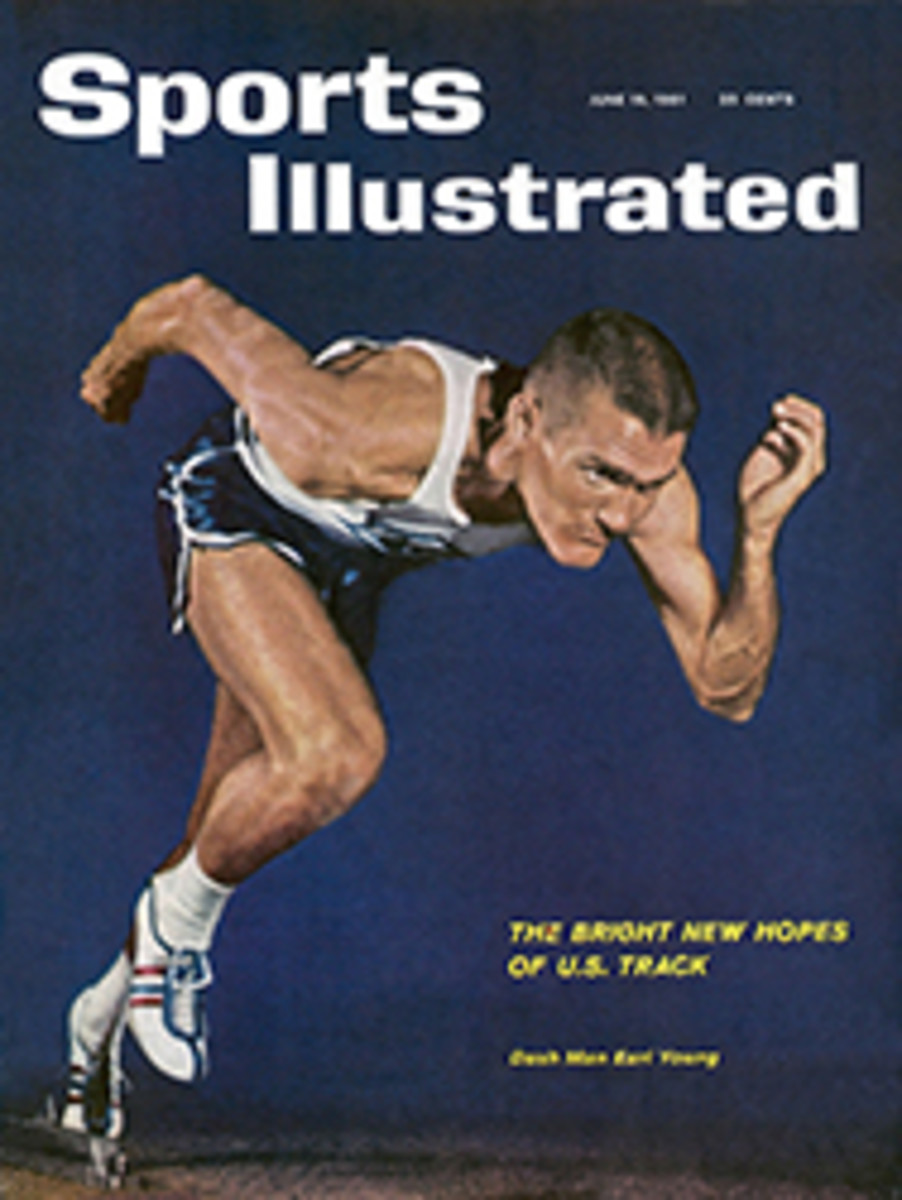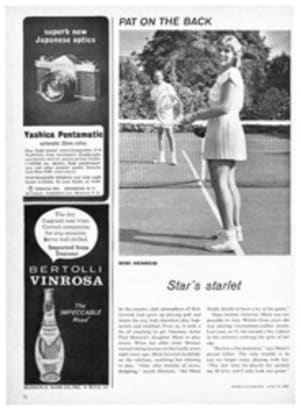
ROUSING DAY FOR U.S. ROWING
If football were rowing, practically all the top college teams in the nation (all but Harvard and Yale, that is) would gather together in one big stadium one afternoon in November, and in a single game would settle all their conference championships in one desperate dash down the field. Endlessly exclusive, Harvard and Yale would of course be doing the same thing somewhere else.
But rowing is not football; nor indeed is it in any way like any other college sport. So to rowing fans there seems nothing strange in the fact that each year at this time the entire essence of the intercollegiate rowing season is distilled in one June week when two races take place that are virtually unlike any rowed earlier in the season. Even the fans themselves undergo a change for the big races, which this year fall on the same day.
Weekend after weekend in the regular spring season, Harvard and Yale crews race other outfits in their respective rivers to the utter indifference of strollers on the riverbanks. Yet this Saturday thousands of suddenly ardent partisans (opposite) will flock by train, bus, car and private yacht to the delta of the Thames River in New London to watch these Ivy aristocrats race each other in the nation's oldest (109 years) and toughest (four miles) rowing regatta.
At the same time, 300 miles to the northwest, comparable crowds will gather on and off the shores of Syracuse's Onondaga Lake to watch 13 other varsity crews settle their differences in a race tougher than any they have rowed all season—the three-mile Intercollegiate Rowing Association regatta. After a training period of shorter races, every crew enters the IRA with an unknown potential for the long, hard route, but four in particular deserve special attention.
CORNELL. Defeated once this season (but only by unbeaten Navy and then only by inches in the 2,000-meter Eastern Sprints), Cornell's crew is a good-size organization (6 feet 4 inches is the average height, 192 pounds the average weight) of low-stroking, deeply fortified oarsmen. It is basically the same crew that won the Eastern Sprints last year and might have won the IRA if the sophomore stroke had not passed out cold 700 yards from the finish.
CALIFORNIA. This is the crew, with only a few changes, that did win the last IRA. After outrowing a good Washington crew in a 2¾-mile race early this season, California lost by a paint job to the same crew a few weeks later in a 2,000-meter sprint (39 yards short of 1¼ miles). But this is the only mark against an outfit which, according to Coach Jim Lemmon, is "a little bit heavier, and maybe a little bit better" than last year's.
WASHINGTON. Two things give California's rival an extra urge to win. One is a desire to restore crew's prestige in Seattle. In pre-Gold-Cup-hydroplane days it used to attract crowds of 50,000 and up: today if 15,000 attend an important regatta half have come for a picnic and suntan. The other is the very personal desire of oarsmen to recoup their status as athletic celebrities—a status lately lost to the football crowd, whose team has triumphed in the Rose Bowl game two years running. Pulling for crew this year is a varsity boatload that one expert appraised recently as "potentially one of the most powerful ever to row for Washington."
NAVY. Some observers compare this crew with Navy's almost supramortal 1952 Olympic crew. Of the eight men in this year's boat, four are sophomores who last year made Navy's plebe boat the best in Annapolis history—a crew so good it finished fourth in the summer's Olympic trials. Three others are left from the varsity that won the trials.
What makes this formidable combination doubly satisfying to Navy buffs is the fact that it sprang from a crisis that came within an ace of capsizing Navy's entire rowing program. Navy's rowing troubles began two years ago when the late, great Rusty Callow retired after nine years as crew coach at the Academy. Along with everyone else, Callow expected his successor to be Paul Quinn, the very excellent plebe coach who was Callow's protégé. But Captain Slade Cutter, Navy's athletic director, had other plans. Anti-Callow (because of civilian Rusty's ho-hum attitude toward military starchiness) and anti-Quinn (because—dark deed—after graduating fourth in his class, Quinn later resigned his commission), old Navy man Cutter hired an outsider to be head coach. Quinn was left with the plebes.
Cutter's choice for the big job was coxswain-size, high-strung Lou Lindsey, a California schoolteacher who had coxed and, in the 1950s, coached crew at Stanford. Highly regarded by many for his command of occult crew theory, Lindsey "was never," says a man who likes him, "very successful as a leader who could extract hard work and allegiance from young men." This shortcoming, coupled with a natural resentment from partisans of the bypassed Quinn, worked against him. When the call for crew went out early last fall, only a few of the 1960 plebes, turned sophomores, trickled in.
Moving fast to stem the potential mutiny, Captain Asbury Coward, who had succeeded Cutter as athletic director, kicked Lindsey upstairs to a make-work project of "studying the prospects of U.S. rowing in future Olympic Games" and appointed Paul Quinn head coach of the crew. Says Lindsey today, with only a suggestion of bitterness, "I was naive, I suppose, to let myself get involved in such a situation. Coming from the West Coast, 1 just didn't know what had been going on at Annapolis." Says Quinn: "I'm sorry it had to happen to either of us. I was naturally hurt when I was passed over, and Lou was hurt just as bad later on."
Unlike feverish, intense Lou Lindsey, Paul Quinn is a hulking figure of a man with massive hands, an expansive smile, a relaxed, almost delicate manner with oarsmen. Prompting, coaxing and encouraging his boys by a megaphone, he speaks in a voice so confidential that a man at his elbow cannot hear what he says. But beneath his tact and diplomacy Quinn is a relentless faultfinder and nit-picker—as a coach must be to succeed in a sport where even a tiny flaw in one man's style or timing can disrupt the perfection of an entire boatload. Split seconds can and do lose boat races, as Navy itself proved when, pulling in near harmony, it beat Cornell in the Eastern Sprints by four-tenths of a second, hardly more time than it takes to bat an eye.
Quinn seems always to be fussing at his charges like a spinster aunt. "Not quite so much layback," he will mutter privately to his No. 4 man. The correction is a matter of inches. Another does not thrust his sweep into the water with enough precision and is quietly chided. A third is rushing forward on his sliding seat. Gradually, as each tiny imperfection is polished away, the crew approaches its ultimate, machinelike objective: to make the shell cover the greatest amount of water in the shortest time.
This Saturday, while the slim shells glide in seeming effortlessness through the waters of Onondaga Lake and the Thames, Paul Quinn, like the rest of the cheering thousands on the shores and in the moored boats, will become for 15 anguished minutes no more than another spectator. For once a crew race has begun, no coach can do more than hope he has done his work well. While the race is on, his fate rests in the blistered hands and aching muscles of eight oarsmen and a cox who are no more machinelike or perfect than any other human beings.
For one veteran oarsman's analysis of why he chose rowing as a sport, see also related article on page 42.
PHOTO
A SOFT-SPOKEN FAULTFINDER, COACH PAUL QUINN CHECKS WITH AN AIDE AS NAVY'S CREWS WORK OUT ON THE SEVERN

